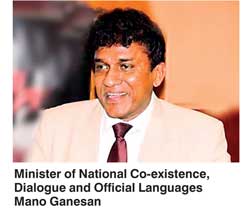Thursday Mar 06, 2025
Thursday Mar 06, 2025
Wednesday, 2 March 2016 00:00 - - {{hitsCtrl.values.hits}}
Many amongst our Parliamentarians ought to be told that it is far wiser to keep their traps shut and be thought of as fools, than open them and remove all doubt!
The latest to put his foot in the mouth – a seemingly favourite pastime of many a politico – is the Minister of National Co-existence, Dialogue and Official Languages Mano Ganesan. 
The Minister of Indian origin appeared to be speaking on behalf of the majority of Tamils of Sri Lanka, when he claimed that “most” Tamils feel that the Government’s claim of 22,254 Tamil Buddhists in the island was a “gross exaggeration”.
So what, if there are 22,254 Tamil Buddhists in the island? If Tamils can embrace Christianity and still retain their identity as Tamils, why can’t they do so with Buddhism? Or, like the Sinhala-Buddhist supremacists, does he also subscribe to the notion that Buddhism is the sole ‘property’ of Sinhala-Buddhists and no other, and thus, to become a Buddhist one is required to change one’s ethnic identity as well?
Is the Minister attempting to create a monster out of thin air by implying, that Tamil Hindus are being converted into Buddhists and hence, into Sinhala-Buddhists? As a Tamil of Indian origin and a Hindu by faith, Minster Ganesan ought to be aware, that for most Buddhists and Hindus, both faiths are intertwined. And this has been the case for aeons before he was born. 
Throughout history, Sinhalese Buddhists have been worshiping at Hindu temples, and Hindus have been visiting Buddhist viharas, without ever changing their faith or ethnic identity. In fact, there is hardly a Buddhist temple to be found in this country without a shrine-room for Hindu Gods within its precincts.
Seemingly forgetting that he is part of the incumbent Government, Ganesan went a step further to add his own view on this purported “gross exaggeration”. According to him, “The Government’s claim might have been made ‘for propaganda purposes,’ to show the dominant Sinhalese-Buddhists that significant inroads have already been made into the largely Hindu Tamil minority.”
Minister Ganesan appears to have been unaware of, or overlooked the fact that the Government’s claim was based on a 2012 official Census, and not concocted for what he terms as “for propaganda purposes”, out of the blues.
Is this what a Government Minister, tasked with the responsibility of promoting ‘National Co-existence’, ought to be saying? This is most worrying, as irresponsible statements such as these is no way to forge post-war peace and reconciliation in this much tormented land, as it gives rise to further tension between the communities.
Apparently coming to his senses a few days later, Ganesan in an interview with a Sunday newspaper retreated from his previous stance on the issue by admitting, “High norms of the human civilisation of this era tell us to treat religion as the private subject and keep it away from the activities of the State.” If this is not a volte face on his previous stance, what is it?
When the Government appoints ministers and create portfolios to appease them, it ought to take cognition of the sensitivity and the responsibility of the subject being assigned, and appoint suitable people who are au fait with, and sensitive to the issues of the relevant portfolio.
In this case, it is the portfolio of ‘National Co-existence’. Given Ganesan’s mindset and stance, is he the suitable person to head a sensitive area as ‘National Co-existence’, in dealing with issues faced by all communities affected in a post-war era?
This ill-conceived and ill-timed statement from Ganesan came hot on the heels of Sri Lanka Muslim Congress (SLMC) Chairman Basheer Segu Dawood’s demand for a separate Muslim Province. This certainly does not bode well at all for the Government’s post-war reconciliation efforts. In fact, it will only serve as grist to the mill of Sinhala-Buddhist racists, hell-bent on keeping the Sinhalese, Tamils and Muslims polarised forever.
Of what use is a peace and reconciliation process, if all its stakeholders – Sinhalese, Tamils and Muslims – don’t speak in one voice?
Discover Kapruka, the leading online shopping platform in Sri Lanka, where you can conveniently send Gifts and Flowers to your loved ones for any event including Valentine ’s Day. Explore a wide range of popular Shopping Categories on Kapruka, including Toys, Groceries, Electronics, Birthday Cakes, Fruits, Chocolates, Flower Bouquets, Clothing, Watches, Lingerie, Gift Sets and Jewellery. Also if you’re interested in selling with Kapruka, Partner Central by Kapruka is the best solution to start with. Moreover, through Kapruka Global Shop, you can also enjoy the convenience of purchasing products from renowned platforms like Amazon and eBay and have them delivered to Sri Lanka.
Discover Kapruka, the leading online shopping platform in Sri Lanka, where you can conveniently send Gifts and Flowers to your loved ones for any event including Valentine ’s Day. Explore a wide range of popular Shopping Categories on Kapruka, including Toys, Groceries, Electronics, Birthday Cakes, Fruits, Chocolates, Flower Bouquets, Clothing, Watches, Lingerie, Gift Sets and Jewellery. Also if you’re interested in selling with Kapruka, Partner Central by Kapruka is the best solution to start with. Moreover, through Kapruka Global Shop, you can also enjoy the convenience of purchasing products from renowned platforms like Amazon and eBay and have them delivered to Sri Lanka.